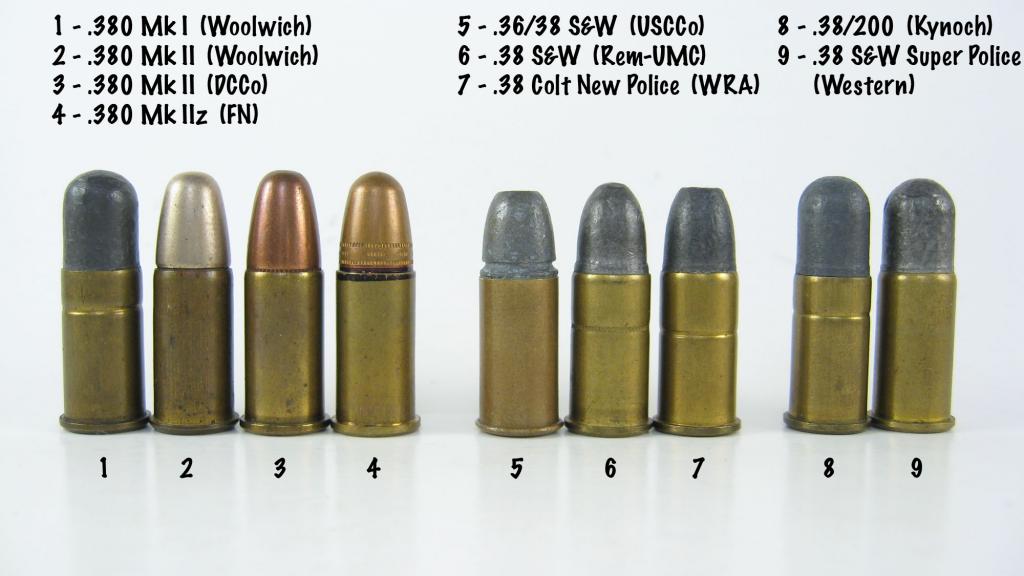-
Legacy Member

The lowly British.38/200 Revolver Cartridge.. Not as underpowered as you might think!
Having just done an extensive article for SASS's Cowboy Chronicle about the .38 (Long) Colt cartridge being the most mis-understood and underrated cartridge of the American West, it got me interested in the British .,38/200. While the British .38/200 MK I only gives about 200 ft lbs energy, from what I have read, it actually performed in combat better than you would think in today's Magnum-Mania line of thought.
.,38/200. While the British .38/200 MK I only gives about 200 ft lbs energy, from what I have read, it actually performed in combat better than you would think in today's Magnum-Mania line of thought.
Unlike the Army's 1892 .38 Long Colt loading (using an inside lubed .357", 150 grain hollow base bullet in a .375" bore) which punched right through the drugged up Moro warriors in the Philippines, the MK I British load with its long, soft 200 grainer immediately tumbled off in odd directions in the body, and seldom over penetrated, delivering all of its energy in the enemy. The British government actually preformed some grizzly tests on fresh cadavers and livestock to see how it performed in tissue. In fact, because of concerns about the 200 grain bullet's soft lead and behavior being in violation of the Geneva Convention, the British replaced it with a 178 grain full metal jacket bullet prior to the war starting The MK II FMJ uses a very long nose still, and from what I have read seems to tumble almost as well as the lead load. BTW, during the war, the British used both MK I lead and Mk II FMJ ammo because of wartime supply needs.
From the IMGUR on web:

The four loads on the left are British MNK I (lead) and Mark II FMJ military loads (DO NOT use in American top breaks!)
The three in the center are American loads, suitable for H&R and Iver Johnson top breaks, The performance of these lightly loaded American top break loads was/is dismal because they are downloaded to be safe in pre-1900 black powder cartridge revolvers.
The two on the left were designed for Colt and Smith & Wesson .38 S&W swing out cylinder revolvers. The British 38/200 is a variation of the this American ".38 super police" 200 grain load that was used in Colt Banker's special and Smith and Wesson Terrier revolvers with swing out cylinders. From what I have seen they are close to the British .38/200 loading and also should not be used in the American 1900ish top breaks.
The power difference between the current Remington and Winchester 145 grain .38 S&W loads (designed to be safe for the early top breaks) and the British load is very noticeable. The "break top safe" loads only give about 140-150 ft lbs from a 6" barrel, and 120 ft pounds from a 3" break top! The British service rounds give about 200 ft lbs.
As an interesting aside, Buffalo Bore makes a 125 grain hard cast flat nose .38 S&W load that give 1030+ fps from a Webley or Enfield for 277 ft lbs. They maintain they are perfectly safe in these revolvers (but not the old US top breaks). That is a viable round, even by today's standards.
Information
 |
Warning: This is a relatively older thread
This discussion is older than 360 days. Some information contained in it may no longer be current. |
|
Last edited by imarangemaster; 12-04-2020 at 10:15 PM.
-
The Following 6 Members Say Thank You to imarangemaster For This Useful Post:
-
12-04-2020 10:22 PM
# ADS
Friends and Sponsors

-
Legacy Member

I have four or five unopened little green wood boxes of 38sw complete with rope carry handles.
I bought it many year's ago along with webley and Enfield revolversthat came from New Zealand
I also got the 455 revolvers, but, there was no ammo
-
-
Legacy Member

I have a few boxes of the Buffalo Bore ammo. Haven’t tried it out yet though.
-
-
Contributing Member


I have replicated the .38/200 loads for the .38 special in short barreled swing revolvers. I did not like the all of the recoil required to get the soft points and hollow points to expand. The tests that i have done using just several card target backers spaced apart. The rounds start to tumble on impact with the first cardboard backer. I cast the 200gr MKI bullet with my loads.
-
Thank You to fjruple For This Useful Post:
-
Legacy Member

38 S&W
I also reload the 38 S&W more for accuracy than self defense, Some years back I converted two Uberti revolvers (1851 and 1861) that were incomplete/junkers to cartridge. Fortunaterly I had two modern steel 38 S&W cylinders that I used. I had to make the other parts.
Accuracy was poor until I used and made some hollow base bullets, these are accurate at myAttachment 114256Attachment 114257 test target at 20 feet
-
Thank You to RCS For This Useful Post:
-
Legacy Member

When my nephews were growing up they loved to shoot my Webley;
I loaded them with 158 gr lead round nose bullets with bullseye powder.
At the cinder pit with the sun just right, you could see the flight of the bullets.
They're in their 50's now and still remember shooting the Webleys.
AZb
-
.,38/200. While the British .38/200 MK I only gives about 200 ft lbs energy, from what I have read, it actually performed in combat better than you would think in today's Magnum-Mania line of thought.
















 PM
PM







